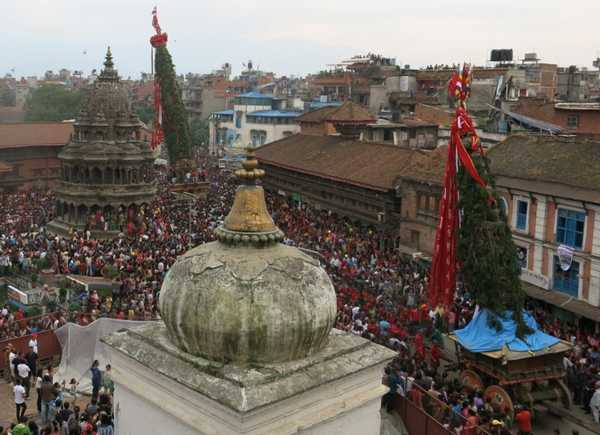Buṃgadyaḥ Procession in Patan
A heritage walk curated by Christiane Brosius and Monalisa Maharjan (2021)
The chariot procession (rathayātrā) of Buṅgadyaḥ is performed to ask for rain and a good harvest. It is associated with fertility and with water and snake deities. It sets out from Pulchok, close to the western Aśoka Stūpa of Patan (LAL0610) where the chariot is built and pulled through the historic city of Patan. The final stop is Jawlakhel, where a small jewelled vest (bhoṭo), believed to have been worn by Buṅgadyaḥ, is displayed. The procession commences on the fourth day of the bright fortnight of Vaiśākha (April-May) and lasts up to several months.
Apart from the annual procession in Patan, the deity is taken on an extended procession every twelve years. The chariot is then built in Buṅgamati (see Heritage Focus Areas) from new materials, except for the gilded parts. It is pulled cross the Nakhu River, through Bhanimandal in the south of Patan, Jhamsikhel, and the historic city of Patan before returning to Buṅgamati.
The procession highlights the involvement of local communities in ritual activities and the responsibilities of guthis established to ensure the correct performence of rituals and to look after the sites where they take place. Sometimes, inscriptions are fixed in the rest houses (phalcā) along the route regulating the provision of food to the deity and to devotees and ritual experts, the lighting of oil lamps, and the distribution of ritual food (samaybaji) including items such as curd, beaten and popped rice or dried beans, and rice beer (thvaṃ). Members of the guthi and individual households deliver ritual offerings when the chariot, accompanied by a smaller chariot of Mīnanātha, stops at specified locations on the route.
The auspicious dates and times of the Buṅgadyaḥ procession are defined by astrologers in the northern Maṇimaṇḍapa (LAL1361) at the Patan Darbar Square. In the last two weeks before the procession starts, around 40-50 members of the Bārāhī caste (carpenters of the Buṅgadyaḥ chariot) get involved in constructing the chariot (ratha) at the Dhaḥmā Phalcā (LAL4306) and other places, especially Taḥ Bāhāḥ.
The procession route includes locations such as Gā Bāhāla, Nugaḥ (Sundhārā), Lagankhel, Thati and Jawlakhel where it ends with the display of the bhoṭo.
















































